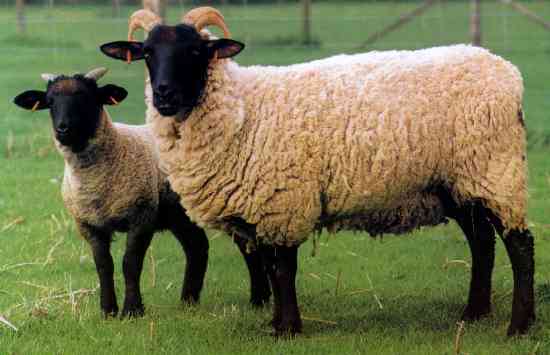Type the name of the breed you're looking for below
[wpdreams_ajaxsearchlite] Don't see the breed your're looking for? Click here and let us know!
Norfolk Horn sheep
| Place of Origin | United Kingdom |
| Origin | The Norfolk Horn (also known as Blackface Norfolk Horned, Norfolk Horned, Old Norfolk or Old Norfolk Horned) is one of the British black-faced sheep breeds. It differs from other black-faced breeds which are mainly found in high-rainfall, upland areas, and from most other modern, lowland British sheep breeds in being lightly built and very hardy. This breed is raised primarily for meat. It was popular in Norfolk until the middle 19th century, when "improved" breeds such as the Leicester and Southdown appeared. Norfolk Horn ewes were mated to Southdown rams to produce high quality meat-producing lambs, and this cross became established as a separate breed, the Suffolk. The Norfolk Horn breed fell to only one flock in 1919, and was built up a survived due to the efforts of one man Mr J.D.Sayer who built up the flock which was divided between himself and the Cambridge animal research university then to only 10 registered ewes and two rams. By 1950 though there were unregistered stock. The breed was revived through the efforts of the Rare Breeds Survival Trust (RBST) at the National Agricultural Centre, Stoneleigh and at Aldenham Country Park, Hertfordshire. With a shortage of pure-bred fertile rams (the last pure-bred ram died in 1973), related breed, the Suffolk, and unrelated breeds such as the Wiltshire Horn and Swaledale, were used to produce animals over 90% (15/16ths) Norfolk Horn. In 1986, the breed was recognised by the RBST, appearing on their Priority List at that time as "Category 1, Critical". The breed has since increased in numbers, and was rated in the 2007 RBST watchlist as "Category 4, At Risk". |
| Purpose | Meat |
| Characteristics | The Norfolk Horn developed on the sandy heathlands of the Breckland area of Norfolk, England although similar black-faced sheep were formerly more widespread in lowland Britain. It is adapted to surviving on poor forage in cool but dry environments. The breed is long-legged with black faces and legs. Both sexes have horns, although these are larger in the male. At maturity, a ewe weighs about 70 kg (150 lb). The breed is described as "flighty" and is likened to goats in their ability to jump over obstacles such as fencing. |



